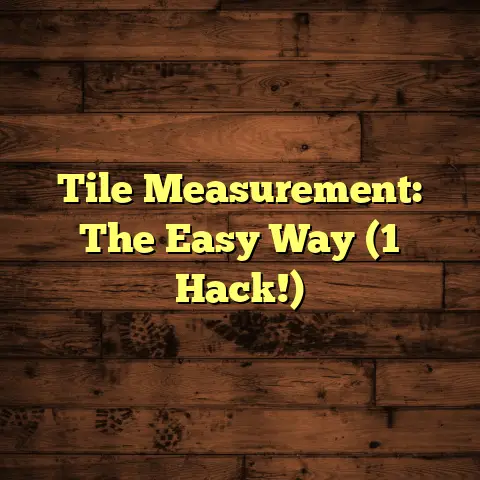Repair Garage Floor Damage: Help! (6 Steps)
Let’s talk garages.
We often think of them as just a place to park our cars and stash our tools.
But think about it:
For many of us, the garage is the first thing guests see.
It’s often the entry point to our homes.
A clean, well-maintained garage floor screams “pride of ownership.”
A cracked, stained mess?
Well, that might give off a different vibe.
I’m here to tell you that tackling garage floor damage isn’t just about looks.
It’s about safety, protecting your belongings, and boosting your home’s value.
I’ve seen it all in my years as a flooring contractor.
From minor hairline cracks to full-blown concrete disintegration, I’ve fixed it.
And I’m here to share my know-how with you.
Ready to roll up your sleeves and get started?
Let’s dive into my 6-step guide to repairing garage floor damage!
Section 1: Understanding Garage Floor Damage
So, what kind of damage are we talking about?
Let’s break down the usual suspects:
-
Cracks: These can range from hairline fractures to wide, deep fissures. They’re usually caused by stress, settling, or temperature fluctuations.
-
Stains: Oil, grease, rust, paint – you name it. Garages are stain magnets. Some stains are just unsightly, while others can weaken the concrete.
-
Spalling: This is when the surface of the concrete starts to flake or crumble. It’s often caused by water penetration and freeze-thaw cycles.
-
Moisture Issues: Dampness can lead to mold growth, corrosion, and other problems. It’s often caused by poor drainage or a lack of a vapor barrier.
And what causes all this mayhem?
Well, a few things:
-
Weather: Extreme temperatures, rain, and snow can all take a toll.
-
Heavy Loads: Parking heavy vehicles or storing heavy equipment can stress the floor.
-
Chemical Spills: Car fluids, solvents, and other chemicals can damage the surface.
-
Age: Over time, concrete can simply deteriorate due to wear and tear.
Ignoring these issues isn’t a good idea.
Cracks can widen, stains can become permanent, and spalling can worsen.
This can create tripping hazards, damage your stored items, and lower your property value.
Trust me, addressing these problems early will save you headaches (and money) down the road.
Section 2: Assessing the Damage
Okay, time to put on your detective hat.
We need to figure out exactly what we’re dealing with.
Here’s how to assess the damage:
-
Clear the Area: Remove everything from your garage floor so you can see the entire surface.
-
Visual Inspection: Grab a flashlight and take a close look at the floor. Look for cracks, stains, spalling, and any other signs of damage.
-
Check for Moisture: Use a moisture meter to check for dampness in different areas of the floor. Pay special attention to areas near the walls or where water might accumulate.
-
Assess Crack Depth: Use a screwdriver or putty knife to probe the cracks and determine their depth. This will help you choose the right repair method.
-
Identify Stains: Try to identify the type of stain (oil, rust, etc.) so you can use the appropriate cleaning solution.
Here’s a quick rundown of the tools you’ll need:
- Flashlight: For those hard-to-see spots.
- Level: To check for uneven surfaces.
- Moisture Meter: To detect dampness.
- Screwdriver/Putty Knife: To probe cracks.
- Measuring Tape: To measure the size of cracks and damaged areas.
- Camera: To document the damage before and after repairs (trust me, you’ll want those “before” shots!).
If you have an epoxy or tile floor, the assessment process is a bit different.
Look for chips, cracks, or loose tiles.
Check for bubbling or peeling in epoxy coatings.
These issues can indicate moisture problems or poor adhesion.
Remember, a thorough assessment is key to choosing the right repair strategy.
Don’t skip this step!
Section 3: Preparing for Repairs
Alright, we know what we’re up against.
Now it’s time to gather our supplies and prepare our workspace.
Here’s what you’ll need for common repairs:
-
Concrete Patching Compound: For filling cracks and holes. Look for a product that’s specifically designed for garage floors.
-
Epoxy: For resurfacing or sealing the floor. Choose a high-quality epoxy that’s resistant to chemicals and abrasion.
-
Concrete Sealer: To protect the floor from moisture and stains.
-
Degreaser: To remove oil and grease stains.
-
Concrete Etcher: To prepare the surface for patching or sealing.
-
Wire Brush: To remove loose debris and roughen the surface.
-
Shop Vacuum: To clean up dust and debris.
-
Mixing Bucket: For mixing patching compound or epoxy.
-
Trowel/Putty Knife: For applying patching compound or epoxy.
-
Paint Roller/Brush: For applying sealer.
-
Safety Glasses: To protect your eyes from dust and chemicals.
-
Gloves: To protect your hands.
-
Dust Mask/Respirator: To protect your lungs from dust and fumes.
Safety first, always!
Before you start any repair work, clear everything out of your garage.
You’ll need plenty of space to work.
Sweep or vacuum the floor to remove any loose debris.
If you’re using any chemicals, make sure you have proper ventilation.
Open the garage door and windows to allow fresh air to circulate.
Trust me, you don’t want to be breathing in those fumes.
A clean and safe workspace is essential for a successful repair.
Take the time to prepare properly, and you’ll be glad you did.
Section 4: Step-by-Step Repair Process
Okay, let’s get down to business!
Here’s my step-by-step guide to repairing common garage floor problems:
Step 1: Cleaning the Garage Floor
Before you do anything else, you need to clean the garage floor thoroughly.
This will remove dirt, grease, and debris that could interfere with the repair process.
-
Sweep or Vacuum: Remove any loose dirt, dust, or debris from the floor.
-
Degrease: Apply a degreaser to any oil or grease stains. Let it sit for the recommended time, then scrub with a stiff brush.
-
Etch the Concrete: Use a concrete etcher to prepare the surface for patching or sealing. This will help the repair materials adhere properly.
-
Rinse Thoroughly: Rinse the floor with clean water to remove any remaining etcher or cleaning solution.
-
Dry Completely: Allow the floor to dry completely before proceeding to the next step.
For tough stains, you might need to use a specialized stain remover.
Here are a few options:
-
Oil Stains: Try a commercial oil stain remover or a mixture of baking soda and water.
-
Rust Stains: Use a rust remover or a mixture of lemon juice and salt.
-
Paint Stains: Use a paint remover or a scraper to remove dried paint.
Always follow the manufacturer’s instructions when using any cleaning products.
And remember to wear safety glasses and gloves to protect yourself.
Step 2: Repairing Cracks and Holes
Now it’s time to tackle those cracks and holes.
Here’s how to do it:
-
Widen the Cracks: Use a chisel or crack chaser to widen the cracks slightly. This will create a better surface for the patching compound to adhere to.
-
Clean the Cracks: Use a shop vacuum to remove any debris from the cracks.
-
Mix the Patching Compound: Mix the patching compound according to the manufacturer’s instructions.
-
Apply the Patching Compound: Use a trowel or putty knife to apply the patching compound to the cracks and holes.
-
Smooth the Surface: Use the trowel or putty knife to smooth the surface of the patching compound.
-
Cure the Patching Compound: Allow the patching compound to cure according to the manufacturer’s instructions.
When choosing a patching compound, look for one that’s specifically designed for concrete repair and that’s resistant to cracking and shrinking.
For deep holes, you might need to apply the patching compound in layers, allowing each layer to dry before applying the next.
Step 3: Addressing Stains
Stains can be a real eyesore, but they’re usually not too difficult to remove.
Here’s how to tackle common garage floor stains:
-
Oil Stains: Apply a degreaser to the stain and let it sit for the recommended time. Scrub with a stiff brush and rinse with water. You can also try using a poultice made from baking soda and water.
-
Rust Stains: Apply a rust remover to the stain and let it sit for the recommended time. Scrub with a stiff brush and rinse with water. You can also try using a mixture of lemon juice and salt.
-
Paint Stains: Use a paint remover to soften the paint, then scrape it off with a putty knife. Clean the area with a solvent to remove any remaining paint residue.
For stubborn stains, you might need to repeat the cleaning process several times.
You can also try using a pressure washer to remove stains, but be careful not to damage the concrete.
Step 4: Resurfacing the Garage Floor
If your garage floor is severely damaged, you might need to resurface it.
This involves applying a new layer of concrete or epoxy over the existing floor.
Here’s a general overview of the process:
-
Prepare the Surface: Clean the floor thoroughly and repair any cracks or holes. Etch the concrete to create a rough surface for the resurfacing material to adhere to.
-
Mix the Resurfacing Material: Mix the resurfacing material according to the manufacturer’s instructions.
-
Apply the Resurfacing Material: Use a trowel or squeegee to apply the resurfacing material to the floor.
-
Smooth the Surface: Use a trowel or squeegee to smooth the surface of the resurfacing material.
-
Cure the Resurfacing Material: Allow the resurfacing material to cure according to the manufacturer’s instructions.
Resurfacing can be a challenging project, so you might want to consider hiring a professional contractor.
Step 5: Sealing the Floor
Sealing your garage floor is crucial for protecting it from moisture, stains, and other damage.
Here’s how to seal the floor:
-
Clean the Floor: Make sure the floor is clean and dry before applying the sealer.
-
Apply the Sealer: Use a paint roller or brush to apply the sealer to the floor. Apply a thin, even coat.
-
Allow to Dry: Allow the sealer to dry according to the manufacturer’s instructions.
-
Apply a Second Coat (Optional): For extra protection, you can apply a second coat of sealer.
When choosing a sealer, look for one that’s specifically designed for concrete floors and that’s resistant to chemicals and abrasion.
There are two main types of sealers:
-
Penetrating Sealers: These sealers penetrate the concrete and create a barrier against moisture and stains.
-
Topical Sealers: These sealers form a protective coating on the surface of the concrete.
Step 6: Regular Maintenance Tips
Once you’ve repaired and sealed your garage floor, it’s important to maintain it properly to prevent future damage.
Here are a few tips:
-
Clean Up Spills Immediately: Wipe up any spills as soon as they happen to prevent stains from setting in.
-
Sweep Regularly: Sweep the floor regularly to remove dirt and debris.
-
Use a Floor Mat: Place a floor mat under your car to protect the floor from oil and other fluids.
-
Avoid Harsh Chemicals: Avoid using harsh chemicals or abrasive cleaners on the floor.
-
Reseal as Needed: Reseal the floor every few years to maintain its protection.
By following these simple maintenance tips, you can keep your garage floor looking great for years to come.
Section 5: Conclusion: The Benefits of a Well-Maintained Garage Floor
So, there you have it!
My 6-step guide to repairing garage floor damage.
I know it might seem like a lot of work, but trust me, it’s worth it.
A well-maintained garage floor not only looks great, but it also:
-
Increases Safety: By eliminating tripping hazards and preventing slips and falls.
-
Protects Your Belongings: By preventing moisture and damage to your stored items.
-
Boosts Your Home’s Value: By creating a positive first impression for visitors and potential buyers.
Don’t let garage floor damage drag down the look and value of your home.
Take action today and restore your garage floor to its former glory.
You’ll be glad you did!
And hey, if you’re feeling overwhelmed, don’t hesitate to call a professional flooring contractor.
We’re here to help!





